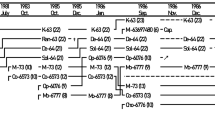Abstract
Troop desertions by females which were observed in Japanese macaque troops at Ryozenyama between 1969 and 1978 are described and the factors which drive females out from the troop are discussed with reference to the troop desertion by males and to the social structure of Japanese macaques. There were 14 cases and altogether 22 female deserters of 5 or more years old; ratio(%) of frequency of the female desertion to the total number of females was 9.48 a year. Female deserters of less than 10 years old had no mother in the troop and belonged to rather isolated kin-groups on the periphery of the troop prior to desertion except for those who deserted it with their mothers. Old deserters were not always very peripheral ones and some of them cut kinship bonds when doing so.
Many female deserters were found in or near the moving range of the original troop and some came back to it. They were easily accepted without antagonism and they were expected to retain the potential membership of their natal troop. From these facts it is clear that the basic organization of the troop of Japanese macaques is the kin-group and the animals are bound by the head of the kin-group or elder mothers but that intra-kinship social bonds as well as inter-kinship bonds gradually weaken in old females.
Similar content being viewed by others
References
Fukuda, F., 1979. A pair of love monkeys met after five years.Yasei, 4: 15–17. (in Japanese)
————,M. Muramatsu &S. Tanaka, 1975. Leaving and joining among troops by males of Yugawara T-troop. In:Life History of Male Japanese Monkeys—Advances in the Field Studies of Japanese Monkeys I,K. Wada,S. Azuma &Y. Sugiyama (eds.), Primate Research Institute, Kyoto Univ., Inuyama, pp. 41–46. (in Japanese)
Furuya, Y., 1973. Fissions in the Gagyusan colony of Japanese monkeys. In:Behavioral Regulators of Behavior in Primates,C. R. Carpenter (ed.), Bucknell Univ. Press, Lewisburg, pp. 107–114.
Itani, J., 1972.Social Structure of Primates. Kyoritsu-Shuppan, Tokyo. (in Japanese)
Kano, K., 1964. The second division of the natural troop of Japanese monkeys in Takasakiyama. In:Wild Japanese Monkeys in Takasakiyama,J. Itani,J. Ikeda &T. Tanaka (eds.), Keiso-Shobo, Tokyo, pp. 42–73. (in Japanese)
Koyama, N., 1967. On dominance rank and kinship of a wild Japanese monkey troop in Arashiyama.Primates, 8: 189–216.
————, 1970. Change in dominance rank and division of a wild Japanese monkey troop in Arashiyama.Primates, 11: 335–390.
————,K. Norikoshi &T. Mano, 1975. Population dynamics of Japanese monkeys at Arashiyama. In:Contemporary Primatology,S. Kondo,M. Kawai &A. Ehara (eds.), S. Karger, Basel, pp. 411–417.
Nishimura, A., 1973. On the third fission of a Japanese monkey group at Takasakiyama. In:Behavioral Regulators of Behavior in Primates,C. R. Carpenter (ed.), Bucknell Univ. Press, Lewisburg, pp. 115–123.
Norikoshi, K., 1975. Solitary monkeys.Shizen, 30(5): 35–45. (in Japanese)
Sugiyama, Y., 1960. On the division of a natural troop of Japanese monkeys at Takasakiyama.Primates, 2: 109–148.
————, 1976. Life history of male Japanese monkeys. In:Advances in the Study of Behaviour VII,J. S. Rosenblatt &R. A. Hinde (eds.), Academic Press, London, pp. 255–284.
————, 1977. Reconsideration of the methodology on the study of Japanese monkey society. In:Method and Methodology of Animal Sociology,S. Sakagami,T. Nakamura &Y. Sugiyama (eds.), Kyoritsu-Shuppan, Tokyo, pp. 130–157. (in Japanese)
———— &H. Ohsawa, 1974a. Population dynamics of Japanese macaques at Ryozenyama, Suzuka Mts. I. General view.Jap. J. Ecol., 24(1): 50–59. (in Japanese with English summary)
———— & ————, 1974b. Population dynamics of Japanese macques at Ryozenyama, II. Life history of males. In:Life History of Male Japanese Monkeys—Advances in the Field Studies of Japanese Monkeys I,K. Wada,S. Azuma &Y. Sugiyama (eds.), Primate Research Institute, Kyoto Univ., Inuyama, pp. 55–62. (in Japanese)
———— & ————, 1975. Life history of male Japanese macaques at Ryozenyama. In:Contemporary Primatology,S. Kondo,M. Kawai &A. Ehara (eds.), S. Karger, Basel, pp. 407–410.
Wada, K., 1964. Some observations on the life of monkeys in a snowy district of Japan.Physiol. & Ecol., 12(1–2): 151–174. (in Japanese with English summary)
Author information
Authors and Affiliations
Additional information
A part of the field work was financed by the Grant-in-Aid for Scientific Research of Mombusho (Ministry of Education, Science and Culture, Japan), Nos. 854144, 054152, 354242, 948255 and 248030. The preliminary report of this study is seen in “The Population Genetics of Japanese Monkeys” K. Nozawa (ed.), Kyoto University Primate Research Institute, pp. 41–54, which was written in Japanese.
About this article
Cite this article
Sugiyama, Y., Ohsawa, H. Population dynamics of japanese macaques at ryozenyama: III. Female desertion of the troop. Primates 23, 31–44 (1982). https://doi.org/10.1007/BF02381436
Received:
Accepted:
Issue Date:
DOI: https://doi.org/10.1007/BF02381436




